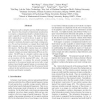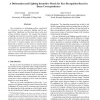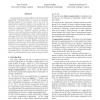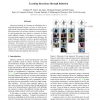CVPR
2011
IEEE
13 years 7 months ago
2011
IEEE
Human saccade is a dynamic process of information pursuit. Based on the principle of information maximization, we propose a computational model to simulate human saccadic scanpath...
CVPR
2011
IEEE
13 years 7 months ago
2011
IEEE
Face recognition is a challenging problem, complicated by variations in pose, expression, lighting, and the passage of time. Significant work has been done to solve each of these...
CVPR
2011
IEEE
13 years 7 months ago
2011
IEEE
We propose to bridge the gap between Random Field (RF) formulations for joint categorization and segmentation (JCaS), which model local interactions among pixels and superpixels, ...
CVPR
2011
IEEE
13 years 7 months ago
2011
IEEE
Current face image retrieval methods achieve impressive results, but lack efficient ways to refine the search, particularly for geometric face attributes. Users cannot easily �...
CVPR
2011
IEEE
13 years 7 months ago
2011
IEEE
In this paper, we design a novel MRF framework which is called Non-Local Range Markov Random Field (NLRMRF). The local spatial range of clique in traditional MRF is extended to th...
CVPR
2011
IEEE
13 years 7 months ago
2011
IEEE
Objects vary in their visual complexity, yet existing discovery methods perform “batch” clustering, paying equal attention to all instances simultaneously—regardless of the ...
CVPR
2011
IEEE
13 years 7 months ago
2011
IEEE
The goal of object category discovery is to automatically identify groups of image regions which belong to some new, previously unseen category. This task is typically performed i...
CVPR
2011
IEEE
13 years 7 months ago
2011
IEEE
Cosegmentation is typically defined as the task of jointly segmenting “something similar” in a given set of images. Existing methods are too generic and so far have not demon...
CVPR
2011
IEEE
13 years 7 months ago
2011
IEEE
Supervised methods for learning an embedding aim to map high-dimensional images to a space in which perceptually similar observations have high measurable similarity. Most approac...
CVPR
2011
IEEE
13 years 7 months ago
2011
IEEE
We describe a generative model of the relationship between two images. The model is defined as a factored threeway Boltzmann machine, in which hidden variables collaborate to de�...




